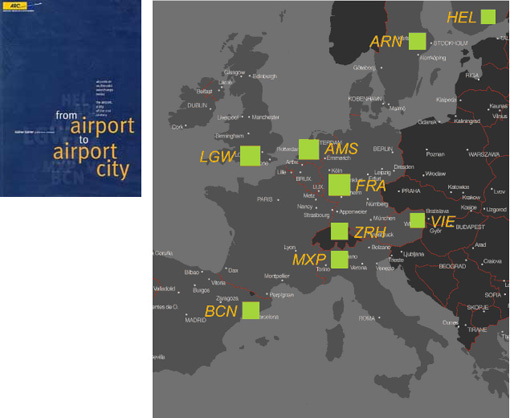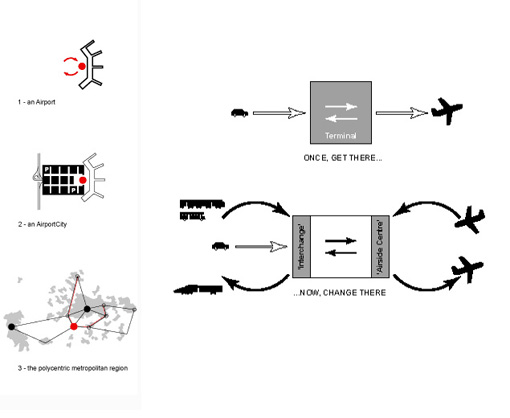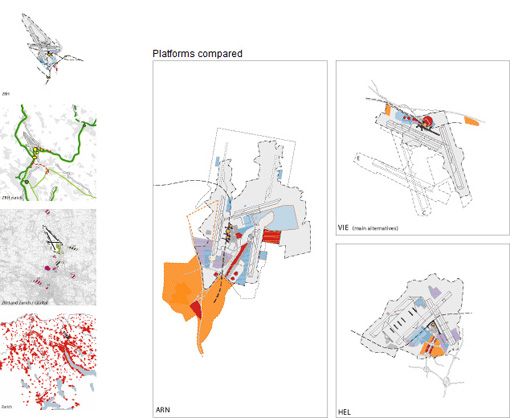client: ARC European Airport Regions Conference, Brussels
team: Güller Güller architecture urbanism
Comparative study on landside interchange nodes as well as urban and economic
development at and around 9 European airports, including the regions of Amsterdam,
Barcelona, Frankfurt, Helsinki, London (Gatwick airport), Milan (Malpensa airport),
Stockholm (Arlanda airport), Vienna, and Zurich.
Airports are no simple traffic-machines anymore.
Airports are amongst the most characteristic elements of metropolitan areas,
decisive motors of their transformation.
Airport development, today, generates phenomena of which airport regions are as yet
little aware. In the report "From Airport to Airport City" we describe how airports,
Airport Cities and Airport Interchanges are now developed, not least to restore
clarity in the relationship between airport and airport region.
Airport regions are not just molested land. To only focus on air traffic growth and
environmental nuisances seems too narrow a view. These are precisely the two aspects
where positions are encrusted and discussions remain unsatisfactory.
The potential of seeing airports in a more differentiated way - the roles they can
play in networks, and their effects on development opportunities - remains unused.
This is all the more critical, as it will strongly influence the development of the
metropolitan area and will have a major impact on the relationship and the forms of
collaboration between the airport and public authorities.
Two new trends: "Airport Cities" and "multimodal interchange nodes"
Airports are not just airports anymore. Airport operators have assumed new business
orientations with a stronger focus on landside developments. Airports increasingly
show the quantitative dimensions and operative requirements of cities, due to a
steadily growing workforce. To cope with land-prices, the airport site will have to
match the quality standards of downtown business districts.
With increasing integration in regional and High Speed Train networks, airports
become focal points of landside transport - "multimodal interchange nodes". As they
enhance their role as regional and global interfaces of European regions, airports
are transforming into centres of activity within them. Their network position is a
strategic advantage that makes airports new development poles, or simply "Airport
Cities".
The airport is no longer a white spot on the map
But local and regional authorities are not yet sure how to handle or participate in
the making of an Airport City and an Airport Interchange, with the consequence that
most schemes are still designed from an airport point of view. Often, the authorities
are not used to the scale of the developments nor to the forms of co-operation
required, and instruments may not be adequate. And, with a straightforward
entrepreneurial reasoning replacing "public" management, and the forthcoming
privatisation of airports, responsibilities between the airport operator and the
surrounding local governments are not clear.
If Airport City and Interchange potentials remain unconsidered, one loses the
opportunity to create value for the disadvantaged parties and to compensate for
nuisances. If an Airport City is built, it must not stay an airport operator's own
venture, but rather become an integral part of the whole region. If accessibility to
the airport is improved, accessibility throughout the region can be improved along
with it: besides the Central Station, a new opportunity to interchange can be offered
to commuters in general.
The challenge: how to fit in Airport City and Interchange?
Airport City and multimodal interchange node are interdependent, the development of
transport infrastructures and of real estate in the airport area cannot be looked at
separately anymore. Otherwise the Airport City and increasing congestion could well
generate additional burdens and new conflicts. A detached Airport City can disturb
the regional balance and simply overrun local economic structures through its size
and development speed. The economic spin-off may end up in the wrong place with
respect to the capacities in transportation networks.
From Airport to Airport City
ARC report, 1999-2000
Airport Regions Conference
download PDF
published by Gustavo Gili in October 2003
ARC report, 1999-2000
Airport Regions Conference
download PDF
published by Gustavo Gili in October 2003



